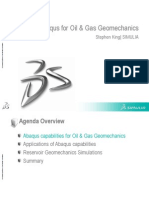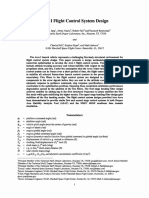Slack Flow
Slack Flow
Uploaded by
Engr AhmadCopyright:
Available Formats
Slack Flow
Slack Flow
Uploaded by
Engr AhmadCopyright
Available Formats
Share this document
Did you find this document useful?
Is this content inappropriate?
Copyright:
Available Formats
Slack Flow
Slack Flow
Uploaded by
Engr AhmadCopyright:
Available Formats
HYDRAULIC GRADE LINE (HGL)
Discussion relating to slack flow requires an understanding of the hydraulic grade line. It is also the basis for operator training and an excellent visual tool to assess the operating limits of the pipeline. The energy line is a graphic representation of Bernoullis equation, expressed in meters of Column height of that particular liquid. The total energy, also referred to as total head (H), is made up of three components: the potential head, or height of the pipeline above sea level (Z); the static head, which is a function of the pressure and the density of the liquid in the pipeline (p/, or pressure expressed in meters of fluid); and the dynamic head, a function of velocity (v2/2g): H = p/ + v2/2g + z (energy line) When plotted as a function of pipeline distance, the total head in meters of liquid is a straight sloped line, assuming a constant pipe diameter and constant liquid density in steady state. The slope of the line represents the loss of head (friction) in the pipeline. Since, in most pipelines, the dynamic head is negligible, this term is eliminated from the equation, and the remaining terms represent the hydraulic grade line, sometimes referred to as the piezometric headline: H = p/ + z (hydraulic grade line) When superimposing the pipeline terrain profile (or potential head Z) on the same plot, the distance between the profile and the hydraulic grade line conveniently represents the pressure in the pipeline expressed in meters of that fluid. Therefore, if fluids of different densities (say slurry and water) are in the same pipeline, at the interface of the two liquids, a discontinuity will appear in the hydraulic gradient. This is because; on one side of the interface the pipeline pressure is expressed in meters of slurry, while on the other side of the interface it is expressed in meters of water. Another set of lines shown on the same graph represent allowable head for steady-state and for transient conditions. These lines are also plotted in meters of fluid, and therefore, will also show a discontinuity at the interface of two batches. For proper operations, the hydraulic gradient must always stay in the area between the allowable headlines and the profile. If the hydraulic grade line intersects the allowable headlines, the pipeline is over-pressured, and if the hydraulic grade line intersects the profile, the flow will go slack (i.e., partially filled pipe). Figure 3 shows commonly used definitions in slurry pipeline engineering.
Allowable head for transient conditions Discontinuity at the Interface of two batches Allowable head for steady state
Hydraulic grade line
Discontinuities at wall thickness change points Head loss of energy dissipation station
p/
Pipeline Profile
Figure 3: Definitions used in slurry pipeline engineering
SLACK FLOW Slack flow means that the fluid transported does not fill the cross section of the pipeline. This condition occurs when the pressure in the pipeline drops to the liquids vapor pressure, which for water is 6m to 10m, depending on altitude and water temperature. However, for practical purposes, PSI considers slack flow to occur when p/ = 0, or when the hydraulic grade line H = z. Graphically, this means that we consider slack flow to occur when the hydraulic grade line intersects the profile as shown in the Figure 1.
Slack flow section
Slurry batch
Water batch
Figure 1: Representation of slack flow
Physically, when the pressure drops below the vapor pressure, we encounter an open channel flow regime, with flow velocities many times higher than for the full-pipe flow regime. In open channel conditions, the velocity (a function of the pipe diameter, the pipe grade, as well as the flow rate in the pipeline) is usually unacceptably high for slurry flow due to wear and cavitation considerations. A concentrate pipeline is expected to have a life of at least 20 years, with little to no wear when operating in a packed condition. However, when subjected to continuous slack flow, wear could erode the pipe very rapidly.
If slack flow avoidance were only a matter of maintaining the flow rate in the pipeline high enough, it would not be an issue. However, when liquids of different densities flow in a pipeline with an undulating profile, slack flow can develop when the interface of the two dissimilar liquids moves into a low point of the profile, and the denser liquid is upstream. Figures 2 and 3 show the HGL for a slurry/water batch combination at different interface locations. In both cases the flow rate is the same and the density of the slurry is assumed to be twice that of water. In Figure 2 there is no slack flow, in Figure 3, where the interface is in the valley, slack flow occurs in the slurry batch in the upstream leg of the valley.
Figure 2: No slack flow
Figure 3: Slack flow occurs when slurry pushes water down
We have shown in Figure 4, a scenario with slurry on the upstream side of the valley, and water on the downstream side, causing slack flow. However, under the same flow conditions, but with water on the upstream side of the valley and slurry on the downstream side, over-pressure occurs, as shown in Figure 5.
Figure 4: No over-pressure
Figure 5: Over-pressure occurs when water pushes slurry down
Inserting water batches between the slurry batches to mitigate possible crosscontamination requires more complex operating procedures. The densities of the copper and zinc slurries are approximately twice that of the adjoining water, and conditions of slack flow (partially filled pipe) and over-pressure (pressure exceeds pipe allowable) can develop as the interfaces move through the pipeline in mountainous terrain. Both conditions are detrimental to the integrity of the pipeline but can be prevented with adjustable energy dissipation (choke) stations and careful operation of the pipeline .
You might also like
- Study Improves Control of Slack Line Flow - Oil & Gas JournalDocument10 pagesStudy Improves Control of Slack Line Flow - Oil & Gas Journalchemsac2No ratings yet
- Estimate Two-Phase Flow in Safety DevicesDocument5 pagesEstimate Two-Phase Flow in Safety DevicesHoang-Vu BuiNo ratings yet
- Designing For Pressure Releases-Part 2Document6 pagesDesigning For Pressure Releases-Part 2john VilladaNo ratings yet
- Timber Pole Cantilever Wall Worked Example 1Document9 pagesTimber Pole Cantilever Wall Worked Example 1Anonymous jbvNLNANLINo ratings yet
- Abaqus For Oil & Gas Geomechanics: Stephen King - SIMULIADocument28 pagesAbaqus For Oil & Gas Geomechanics: Stephen King - SIMULIAalistugui100% (1)
- Flare Systems-Conclusion Safety, Noise, and Emissions Elements Round Out FlaDocument10 pagesFlare Systems-Conclusion Safety, Noise, and Emissions Elements Round Out FlaJR RomanNo ratings yet
- Line Sizing HYSYS PDFDocument1 pageLine Sizing HYSYS PDFrohitkush100% (1)
- Rupturedisk CheresourcesDocument9 pagesRupturedisk Cheresourcessammar_10100% (1)
- 1 s2.0 S0255270107002231 MainDocument10 pages1 s2.0 S0255270107002231 MainJuanIgnacio1No ratings yet
- P & I Design LTD: Emergency Relief System (Ers) Sizing Software Methods & PracticeDocument29 pagesP & I Design LTD: Emergency Relief System (Ers) Sizing Software Methods & PracticeATUL SONAWANE100% (1)
- Select Best Model Two-Phase Relief Sizing: The ForDocument9 pagesSelect Best Model Two-Phase Relief Sizing: The Forjowar100% (1)
- Cenários Sobrepressão Conforme API RP 521Document3 pagesCenários Sobrepressão Conforme API RP 521Adilmar E. NatãnyNo ratings yet
- 521taaai 2Document7 pages521taaai 2Erwin FerdianNo ratings yet
- (C Pi LST 0001 Rev.0) C Pi LST 0001 - 0 (Line List)Document207 pages(C Pi LST 0001 Rev.0) C Pi LST 0001 - 0 (Line List)Harender SinghNo ratings yet
- Baumann NoiseDocument5 pagesBaumann NoiseEnrique RieraNo ratings yet
- Phast Micro: Tutorial ManualDocument34 pagesPhast Micro: Tutorial ManualmelancholicNo ratings yet
- Dynamic DepressuringDocument16 pagesDynamic DepressuringSyedAliAsimRizvi100% (1)
- Evaluate Pressure Relief SystemDocument10 pagesEvaluate Pressure Relief SystemayoungaNo ratings yet
- Correctos Calculos en Blow DownDocument4 pagesCorrectos Calculos en Blow Downroberdani12100% (2)
- Built-Up Backpressure at The Outlet Flange of A Pressure Relief ValveDocument8 pagesBuilt-Up Backpressure at The Outlet Flange of A Pressure Relief ValvemkapkNo ratings yet
- What You Should Know About Liquid Thermal - ExpansionDocument4 pagesWhat You Should Know About Liquid Thermal - ExpansionOthman Mat YamanNo ratings yet
- Aspen FLARENET Getting Started PDFDocument62 pagesAspen FLARENET Getting Started PDFPankaj AdhikariNo ratings yet
- Two-Phase Flow Discharge in Nozzles and Pipes - A Unified ApproachDocument6 pagesTwo-Phase Flow Discharge in Nozzles and Pipes - A Unified ApproachAksheyNo ratings yet
- Process Engineer - Blowdown Valve (BDV) To Flare SystemDocument4 pagesProcess Engineer - Blowdown Valve (BDV) To Flare SystemIOCPC100% (1)
- Gas-Liquid Separators Sizing Parameter - Campbell Tip of The MonthDocument8 pagesGas-Liquid Separators Sizing Parameter - Campbell Tip of The MonthBalaji NaikNo ratings yet
- How To Calculate The NPSH of Pump in HYSYSDocument3 pagesHow To Calculate The NPSH of Pump in HYSYSSamuel Onyewuenyi100% (1)
- GPA Kuwait Final Paper 2016aDocument10 pagesGPA Kuwait Final Paper 2016aSdadNo ratings yet
- Flare Line Failure Case, What We Have LearnedDocument20 pagesFlare Line Failure Case, What We Have LearnedNABEEL VMNo ratings yet
- 456Document21 pages456David LapacaNo ratings yet
- API 521 7 Edition Ballot Item 6.1 New Work Item - Potential ASME Code ViolationsDocument14 pagesAPI 521 7 Edition Ballot Item 6.1 New Work Item - Potential ASME Code ViolationsAyadi_Ayman100% (1)
- Is 600 MM Sufficient To Keep BDV FunctionalDocument4 pagesIs 600 MM Sufficient To Keep BDV FunctionalkronafNo ratings yet
- (Hinze, 1955) Fundamentals of The Hydrodynamic Mechanism of Splitting in Dispersion ProcessDocument7 pages(Hinze, 1955) Fundamentals of The Hydrodynamic Mechanism of Splitting in Dispersion ProcessVeli Can CosarNo ratings yet
- Control ValveDocument21 pagesControl ValveaggibudimanNo ratings yet
- 1417 Pipeline Surge Analysis Studies Atmos - PSIGDocument21 pages1417 Pipeline Surge Analysis Studies Atmos - PSIGsmdryz100% (5)
- 13 Steam StrippersDocument10 pages13 Steam StrippersMohsin Ehsan100% (1)
- Shear Stress Though Tapered Pipe Thread - Eng-TipsDocument4 pagesShear Stress Though Tapered Pipe Thread - Eng-TipsrodrigoperezsimoneNo ratings yet
- P 00220141 en 02Document7 pagesP 00220141 en 02fajaraminwahyullah0% (1)
- White Paper - Calculating Safe NPSH (A)Document3 pagesWhite Paper - Calculating Safe NPSH (A)Stephen BeasleyNo ratings yet
- Easily Find The Wetted Surface Area of Side HeadsDocument4 pagesEasily Find The Wetted Surface Area of Side HeadsЛеонид КорельштейнNo ratings yet
- Liquid Hydraulic Expansion - PSVDocument3 pagesLiquid Hydraulic Expansion - PSVOlumuyiwa FasehunNo ratings yet
- ASPEN-HYSYS Simulation of Natural Gas PR PDFDocument6 pagesASPEN-HYSYS Simulation of Natural Gas PR PDFvlananlo100% (1)
- Flare Modeling ParametersDocument26 pagesFlare Modeling ParametersHarryBouterNo ratings yet
- Safety Valve Sizing Reliefv PDFDocument9 pagesSafety Valve Sizing Reliefv PDFLiam MoylanNo ratings yet
- 08 ColumnPressureRelief PDFDocument10 pages08 ColumnPressureRelief PDFtaeebNo ratings yet
- Control Valve CoefficientsDocument2 pagesControl Valve Coefficientsjroper100% (1)
- Flare Safe PDFDocument19 pagesFlare Safe PDFghasem_7269902870% (1)
- Relief Valve Tutorial Spirax SarcoDocument16 pagesRelief Valve Tutorial Spirax SarcoamokhtaNo ratings yet
- Thrust Force Calculations For Pressure S PDFDocument11 pagesThrust Force Calculations For Pressure S PDFJupni MulyanaNo ratings yet
- 38365-Getting Started-BlowDown PDFDocument27 pages38365-Getting Started-BlowDown PDFgion_ro401No ratings yet
- Chem Processing - Thermal Expansion PSV For PLDocument11 pagesChem Processing - Thermal Expansion PSV For PLace4200No ratings yet
- Deareador C.B. Mod. SM PDFDocument34 pagesDeareador C.B. Mod. SM PDFElmer MendozaNo ratings yet
- Gas Line VelocityDocument3 pagesGas Line Velocityputrude100% (1)
- Theory, Applications and Sizing of Air ValvesDocument11 pagesTheory, Applications and Sizing of Air Valvesretrospect1000No ratings yet
- Choked Flow at PSV Outlet FlangeDocument5 pagesChoked Flow at PSV Outlet FlangeHitesh PanchalNo ratings yet
- Water Hammer With Column SeparationDocument88 pagesWater Hammer With Column SeparationVSMS8678No ratings yet
- CIV 402 Chapter 2 Pipe FlowDocument29 pagesCIV 402 Chapter 2 Pipe FlowAmit RoyNo ratings yet
- Week 11 of Aqs110 Fluid MechanicsDocument7 pagesWeek 11 of Aqs110 Fluid MechanicsKyle DavidNo ratings yet
- Fluid MechanicsDocument19 pagesFluid MechanicsengNo ratings yet
- Viscous Fluid Flow: 5.1 ViscosityDocument6 pagesViscous Fluid Flow: 5.1 Viscositypasser byNo ratings yet
- Lesson 5Document39 pagesLesson 5Marx VillanuevaNo ratings yet
- Flow in Open ChannelsDocument3 pagesFlow in Open Channelskaran5singh-12No ratings yet
- Two Phase FlowDocument4 pagesTwo Phase FlowsindalvaleriNo ratings yet
- Standard Bidding DocumentsDocument80 pagesStandard Bidding DocumentsEngr AhmadNo ratings yet
- Canal and Drainage Amendment Act2015Document1 pageCanal and Drainage Amendment Act2015Engr AhmadNo ratings yet
- To Amend The Khyber Pakhtunkhwa River Protection Ordinance, 2002Document1 pageTo Amend The Khyber Pakhtunkhwa River Protection Ordinance, 2002Engr AhmadNo ratings yet
- BMI Calculator: Units Standard Weight 160 Pounds Height 5 Feet 9 InchesDocument1 pageBMI Calculator: Units Standard Weight 160 Pounds Height 5 Feet 9 InchesEngr AhmadNo ratings yet
- Request For Proposal RFP Mardan 1510Document74 pagesRequest For Proposal RFP Mardan 1510Engr AhmadNo ratings yet
- Ground Water Management in PakistanDocument10 pagesGround Water Management in PakistanEngr AhmadNo ratings yet
- Working Paper Takht Bhai Bypass Road MardanDocument3 pagesWorking Paper Takht Bhai Bypass Road MardanEngr AhmadNo ratings yet
- PC-II Proforma Gujar Garhi Canal ParkDocument12 pagesPC-II Proforma Gujar Garhi Canal ParkEngr AhmadNo ratings yet
- Concrete Curing CompoundDocument6 pagesConcrete Curing CompoundEngr AhmadNo ratings yet
- Rehabilitation of 2/9 Hoti Minor RD:10700 - 11600 in ReachesDocument1 pageRehabilitation of 2/9 Hoti Minor RD:10700 - 11600 in ReachesEngr AhmadNo ratings yet
- Retaining Wall AhmadDocument1 pageRetaining Wall AhmadEngr Ahmad100% (1)
- Feasibility PC-II Proforma Gujar Garhi Canal ParkDocument9 pagesFeasibility PC-II Proforma Gujar Garhi Canal ParkEngr AhmadNo ratings yet
- UET Research Proposal TemplateDocument9 pagesUET Research Proposal TemplateEngr AhmadNo ratings yet
- Vertical Wall DesignDocument1 pageVertical Wall DesignEngr AhmadNo ratings yet
- KP - Gov.pk DownlaodsDocument151 pagesKP - Gov.pk DownlaodsSultan SikanderNo ratings yet
- Design Calculations: Project Site Input Data RRMDocument1 pageDesign Calculations: Project Site Input Data RRMEngr AhmadNo ratings yet
- Stepped Retaining Wall Design CalculationsDocument1 pageStepped Retaining Wall Design CalculationsEngr AhmadNo ratings yet
- Vertical Wall DesignDocument1 pageVertical Wall DesignEngr AhmadNo ratings yet
- Hydraulic Design For Energy GenerationDocument33 pagesHydraulic Design For Energy Generationmasmello2011No ratings yet
- Lacey Design SheetDocument6 pagesLacey Design SheetEngr AhmadNo ratings yet
- Design of GearsDocument64 pagesDesign of GearsFauiqe Yousaf100% (1)
- Design of Box Culvert BridgeDocument25 pagesDesign of Box Culvert BridgeVal Beltran100% (1)
- Calculating Torque and Speed: How Much Torque Do You Need?Document2 pagesCalculating Torque and Speed: How Much Torque Do You Need?Nathaniel HawkesNo ratings yet
- ns26 - 5 Connection Design Handout - 4perDocument28 pagesns26 - 5 Connection Design Handout - 4perHectorNo ratings yet
- Leaf Spring - LongDocument2 pagesLeaf Spring - LongAmeeh TorionNo ratings yet
- Progressive Waves - The One: in Which The Wave Profile PropagatesDocument1 pageProgressive Waves - The One: in Which The Wave Profile PropagatesDash ShaaNo ratings yet
- ARCH MasonryDocument36 pagesARCH MasonryadnanNo ratings yet
- CIE - O Level - Physics Syllabus - 2020-2021Document40 pagesCIE - O Level - Physics Syllabus - 2020-2021astargroupNo ratings yet
- Diffusion and OsmosisDocument6 pagesDiffusion and OsmosisWacoomo TaroomaNo ratings yet
- Carnot's TheorreDocument12 pagesCarnot's Theorremr shantosNo ratings yet
- Hyd DesDocument459 pagesHyd DesDataniel RosarioNo ratings yet
- Field Axial Cyclic Loading Experiments On Piles Driven in Sand PDFDocument14 pagesField Axial Cyclic Loading Experiments On Piles Driven in Sand PDFyousifNo ratings yet
- General Physic 1 Second Quarter Exam New Format 1Document35 pagesGeneral Physic 1 Second Quarter Exam New Format 1Joseph Cabalejo Rebuyas100% (1)
- G8 SCIENCE Q1 Week 2 LAS 1Document1 pageG8 SCIENCE Q1 Week 2 LAS 1shalinee.daydayNo ratings yet
- PDFDocument14 pagesPDFAdetoro Mal PascalNo ratings yet
- Fluid Thermal StructureCoupledAnalysisofGridFinsforHypersonicFlightVehicle1Document13 pagesFluid Thermal StructureCoupledAnalysisofGridFinsforHypersonicFlightVehicle1Maryam JavedNo ratings yet
- Piezo Electric Transducer ReportDocument8 pagesPiezo Electric Transducer Reportأسامة عليNo ratings yet
- All Units - MCQDocument47 pagesAll Units - MCQPrasanth S Assistant ProfessorNo ratings yet
- AHDocument114 pagesAHReyza PrasetyoNo ratings yet
- Kinematics of Pure BendingDocument5 pagesKinematics of Pure BendingRizki Ade KhoirNo ratings yet
- Experiment 03: Measurement of Absolute Viscosity of Fluid by A Saybolt ViscometerDocument4 pagesExperiment 03: Measurement of Absolute Viscosity of Fluid by A Saybolt Viscometer17044 AZMAIN IKTIDER AKASHNo ratings yet
- Process Control Lecture 5 - DR Pratik N Sheth - BITS PDFDocument20 pagesProcess Control Lecture 5 - DR Pratik N Sheth - BITS PDFManik BansalNo ratings yet
- 2 - Lattice GF For FCC-JournalDocument11 pages2 - Lattice GF For FCC-Journaljasad68No ratings yet
- Measurement of Flowing FluidsDocument18 pagesMeasurement of Flowing FluidsWendell Meriel RacasaNo ratings yet
- Bits Principal StressesDocument2 pagesBits Principal StressessimalaraviNo ratings yet
- Set No. 1Document8 pagesSet No. 129viswa12No ratings yet
- Tutorial 4 (Kom)Document1 pageTutorial 4 (Kom)patelsandip1990No ratings yet
- AWB120 Dynamics 03 Harmonic PDFDocument31 pagesAWB120 Dynamics 03 Harmonic PDFRoss WaringNo ratings yet












































































































